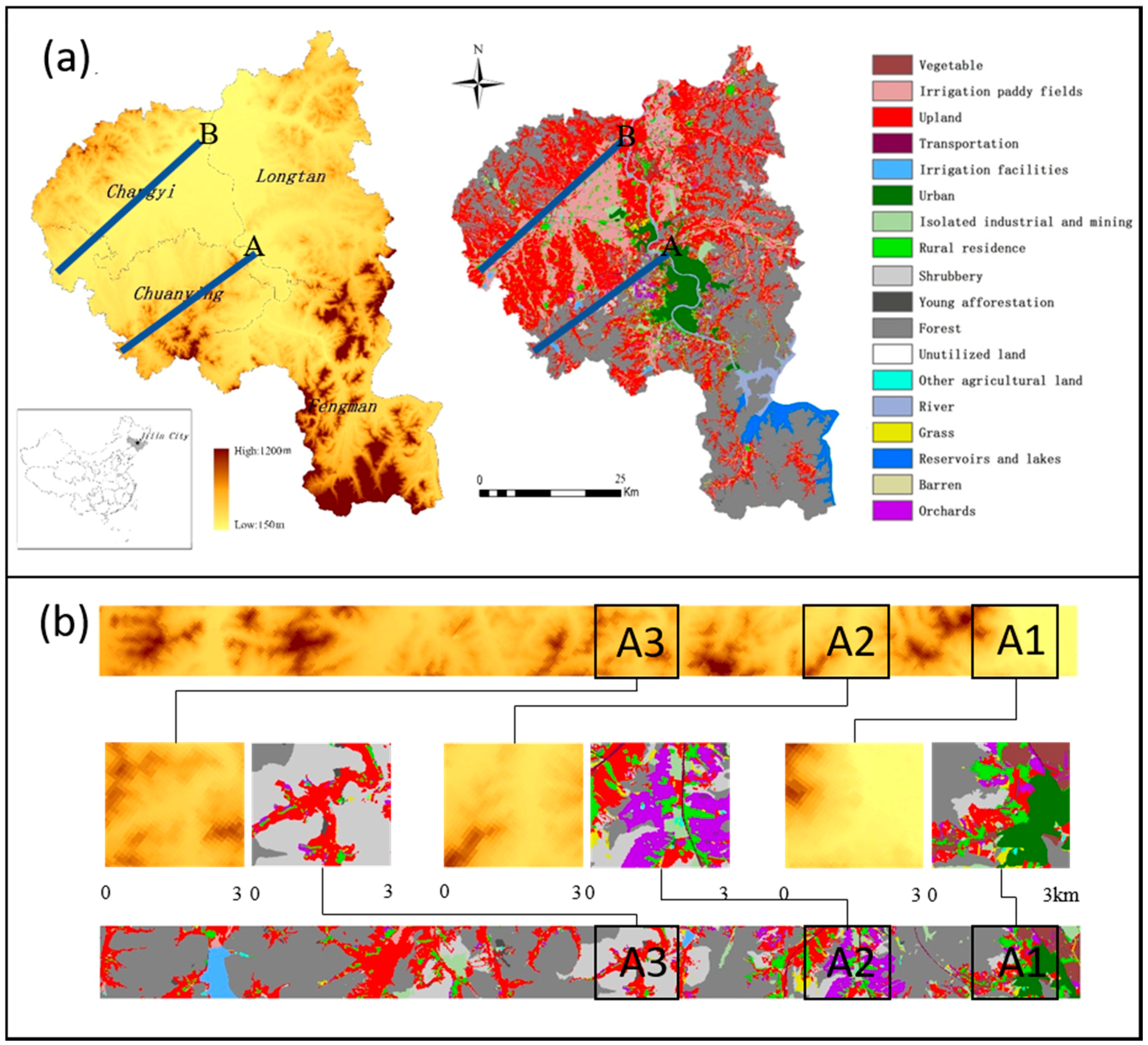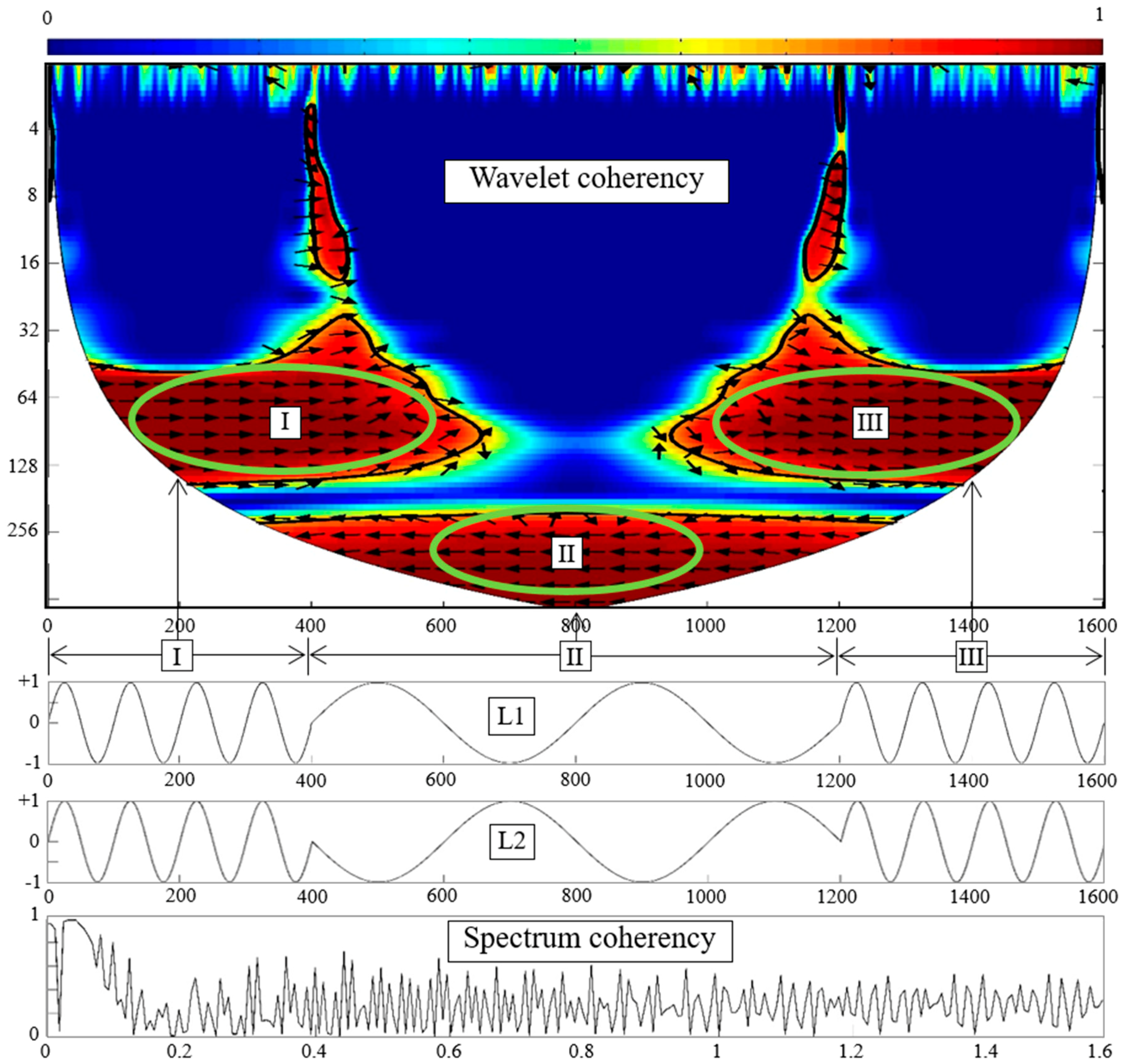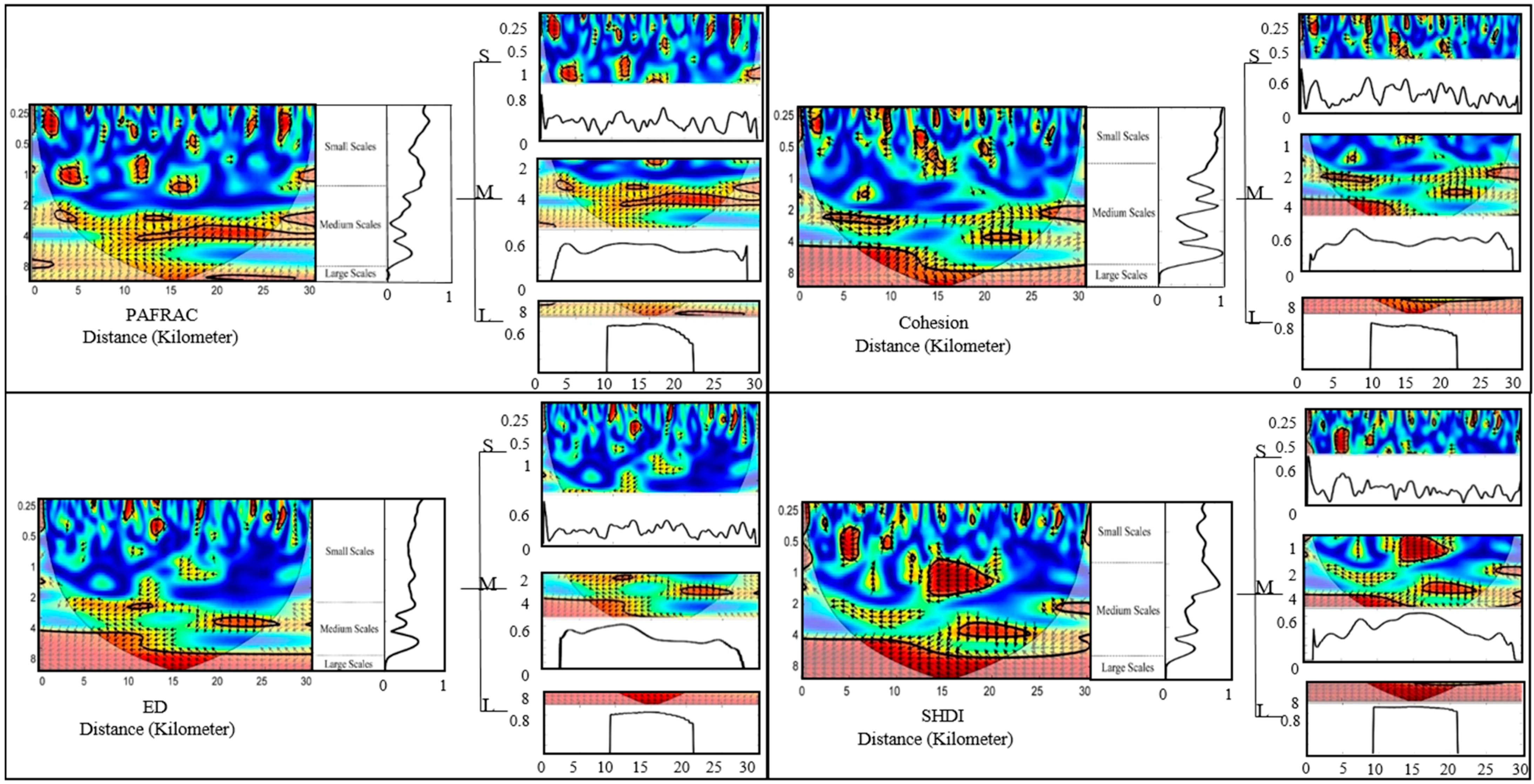Wavelet-Based Correlation Identification of Scales and Locations between Landscape Patterns and Topography in Urban-Rural Profiles: Case of the Jilin City, China
Abstract
:1. Introduction
- (1)
- The effectiveness and adaptability of the Pearson correlation coefficient and wavelet coherency methods in studying the relationship between landscape heterogeneity and topography were analyzed.
- (2)
- The sensitivity of landscape metrics in describing the influence of topography on the landscape pattern, especially the locally correlated features at different scales and locations in an urban-rural profile, were analyzed using the wavelet coherency method.
2. Materials and Methods
2.1. Data
2.2. Pearson Correlation Coefficient
2.3. Continuous Wavelet Transform
2.4. Wavelet Coherency Analysis
2.5. Test of Significance
3. Results
3.1. Overall Pearson Correlation
3.2. The Wavelet Coherencies between Topography Factors and Landscape Indices
4. Discussion
5. Conclusions
- The wavelet analysis was more sensitive than the Pearson correlation coefficient for describing the correlations between landscape patterns and topography at different scales, and the topography was much more related to land use pattern in the complex area than that in the flat area.
- Landscape metrics should not be chosen randomly to study ecological phenomena. This is because some landscape metrics were not sensitive to the terrain variation (e.g., the proximity index), while other selected metrics displayed obvious multi-scale features in describing the influence of the 3D terrain (mainly the elevation and slope) on the landscape pattern.
- The multi-location correlation characteristics at different scales were measured along urban-rural profiles. For example, the influence of traffic lines on the land use distribution within a neighborhood space was indicated only at medium scales in the A2 region, while the correlation was extremely weak at smaller scales and extremely strong at larger scales for the total study area.
- The variation of the correlation period between topography and landscape metrics, especially the decrease shown in the A3 region, can be seen as important evidence that the main influencing factors of landscape pattern gradually changed from human influences to topography.
- The identification of multiple scales and locations using the wavelet method supplies us with new insights into the relationship between landscape heterogeneity and topography. However, this kind of method is still too complex, and the ecological interpretation of wavelet coherencies needs to be supplemented as well as have a more accurate division strategy of scale.
Author Contributions
Funding
Conflicts of Interest
References
- Goodchild, M.F. Spatial Autocorrelation; Geo Books: Norwich, UK, 1986; Volume 47. [Google Scholar]
- Wu, J. Effects of changing scale on landscape pattern analysis: Scaling relations. Landsc. Ecol. 2004, 19, 125–138. [Google Scholar] [CrossRef]
- Fissore, C.; Dalzell, B.J.; Berhe, A.A.; Voegtle, M.; Evans, M.; Wu, A. Influence of topography on soil organic carbon dynamics in a Southern California grassland. Catena 2017, 149, 140–149. [Google Scholar] [CrossRef]
- Hais, M.; Chytrý, M.; Horsák, M. Exposure-related forest-steppe: A diverse landscape type determined by topography and climate. J. Arid Environ. 2016, 135, 75–84. [Google Scholar] [CrossRef]
- Ivanov, V.Y.; Bras, R.L.; Vivoni, E.R. Vegetation-hydrology dynamics in complex terrain of semiarid areas: 2. Energy-water controls of vegetation spatiotemporal dynamics and topographic niches of favorability. Water Resour. Res. 2008, 44, 380–384. [Google Scholar] [CrossRef]
- Fernandes, M.R.; Aguiar, F.C.; Ferreira, M.T. Assessing riparian vegetation structure and the influence of land use using landscape metrics and geostatistical tools. Landsc. Urban Plan. 2011, 99, 166–177. [Google Scholar] [CrossRef]
- Pautasso, M. Scale dependence of the correlation between human population presence and vertebrate and plant species richness. Ecol. Lett. 2007, 10, 16–24. [Google Scholar] [CrossRef] [PubMed]
- Ekroos, J.; Ödman, A.M.; Andersson, G.K.; Birkhofer, K.; Herbertsson, L.; Klatt, B.K.; Rundlöf, M. Sparing land for biodiversity at multiple spatial scales. Front. Ecol. Evol. 2016, 3, 145. [Google Scholar] [CrossRef]
- Mairota, P.; Cafarelli, B.; Labadessa, R.; Lovergine, F.; Tarantino, C.; Lucas, R.M.; Didham, R.K. Very high resolution Earth observation features for monitoring plant and animal community structure across multiple spatial scales in protected areas. Int. J. Appl. Earth Observ. Geoinform. 2015, 37, 100–105. [Google Scholar] [CrossRef]
- Si, B.C.; Zeleke, T.B. Wavelet coherency analysis to relate saturated hydraulic properties to soil physical properties. Water Resour. Res. 2005, 41, 303–306. [Google Scholar] [CrossRef]
- Grimm, N.B.; Pickett, S.T.; Hale, R.L.; Cadenasso, M.L. Does the ecological concept of disturbance have utility in urban social–ecological–technological systems? Ecosyst. Health Sustain. 2017. [Google Scholar] [CrossRef]
- Wu, J. Landscape Ecology: Pattern, Process, Scale and Hierarchy; Higher Education Press: Beijing, China, 2000. [Google Scholar]
- Ma, Q.; Wu, J.; He, C. A hierarchical analysis of the relationship between urban impervious surfaces and land surface temperatures: Spatial scale dependence, temporal variations, and bioclimatic modulation. Landsc. Ecol. 2016, 31, 1139–1153. [Google Scholar] [CrossRef]
- Biswas, A.; Si, B.C. Scales and locations of time stability of soil water storage in a hummocky landscape. J. Hydrol. 2011, 408, 100–112. [Google Scholar] [CrossRef]
- Hiebeler, D.E.; Houle, J.; Drummond, F.; Bilodeau, P.; Merckens, J. Locally dispersing populations in heterogeneous dynamic landscapes with spatiotemporal correlations. I. block disturbance. J. Theor. Biol. 2016, 407, 212–224. [Google Scholar] [CrossRef] [PubMed]
- Zhou, T.; Wu, J.; Peng, S. Assessing the effects of landscape pattern on river water quality at multiple scales: A case study of the Dongjiang River watershed, China. Ecol. Indic. 2012, 23, 166–175. [Google Scholar] [CrossRef]
- Farge, M. Wavelet transforms and their applications to turbulence. Annu. Rev. Fluid Mech. 1992, 24, 395–458. [Google Scholar] [CrossRef]
- Torrence, C.; Compo, G.P. A practical guide to wavelet analysis. Bull. Am. Meteorol. Soc. 1998, 79, 61–78. [Google Scholar] [CrossRef]
- Saunders, S.C.; Chen, J.; Drummer, T.D.; Gustafson, E.J.; Brosofske, K.D. Identifying scales of pattern in ecological data: A comparison of lacunarity, spectral and wavelet analyses. Ecol. Complex. 2005, 2, 87–105. [Google Scholar] [CrossRef]
- Yang, Y.; Zhou, Q.; Gong, J.; Wang, Y. Gradient analysis of landscape spatial and temporal pattern changes in Beijing metropolitan area. Sci. China Technol. Sci. 2010, 53, 91–98. [Google Scholar] [CrossRef]
- Modica, G.; Vizzari, M.; Pollino, M.; Fichera, C.R.; Zoccali, P.; Di Fazio, S. Spatio-temporal analysis of the urban–rural gradient structure: An application in a Mediterranean mountainous landscape (Serra San Bruno, Italy). Earth Syst. Dyn. 2012, 3, 263–279. [Google Scholar] [CrossRef]
- Fichera, C.R.; Modica, G.; Pollino, M. GIS and remote sensing to study urban-rural transformation during a fifty-year period. In International Conference on Computational Science and Its Applications; Springer: Berlin/Heidelberg, Germany, 2011; pp. 237–252. [Google Scholar]
- Vadrevu, K.P.; Choi, Y. Wavelet analysis of airborne CO2 measurements and related meteorological parameters over heterogeneous landscapes. Atmos. Res. 2011, 102, 77–90. [Google Scholar] [CrossRef]
- Chave, J. The problem of pattern and scale in ecology: What have we learned in 20 years? Ecol. Lett. 2013, 16, 4–16. [Google Scholar] [CrossRef] [PubMed]
- Saunders, S.C.; Chen, J.; Crow, T.R.; Brosofske, K.D. Hierarchical relationships between landscape structure and temperature in a managed forest landscape. Landsc. Ecol. 1998, 13, 381–395. [Google Scholar] [CrossRef]
- Biswas, A. Landscape characteristics influence the spatial pattern of soil water storage: Similarity over times and at depths. Catena 2014, 116, 68–77. [Google Scholar] [CrossRef]
- Grinsted, A.; Moore, J.C.; Jevrejeva, S. Application of the cross wavelet transform and wavelet coherence to geophysical time series. Nonlinear Processes Geophys. 2004, 11, 561–566. [Google Scholar] [CrossRef] [Green Version]
- McGarigal, K.; Cushman, S.A.; Neel, M.C.; Ene, R. FRAGSTATS: Spatial Pattern Analysis Program for Categorical Maps. Computer Software Program Produced by the Authors at the University of Massachusetts, Amherst (2002). Available online: http://www.umass.edu/landeco/research/fragstats/fragstats.html (accessed on 1 April 2018).
- Kumar, P.; Foufoula-Georgiou, E. Wavelet analysis for geophysical applications. Rev. Geophys. 1997, 35, 385–412. [Google Scholar] [CrossRef] [Green Version]
- Torrence, C.; Webster, P.J. The annual cycle of persistence in the El Nño/Southern Oscillation. Q. J. R. Meteorol. Soc. 1998, 124, 1985–2004. [Google Scholar] [CrossRef]
- Pardo-Igúzquiza, E.; Rodríguez-Tovar, F.J. The permutation test as a non-parametric method for testing the statistical significance of power spectrum estimation in cyclostratigraphic research. Earth Planet. Sci. Lett. 2000, 181, 175–189. [Google Scholar] [CrossRef]
- Dietrich, W.E.; Wilson, C.J.; Montgomery, D.R.; McKean, J. Analysis of erosion thresholds, channel networks, and landscape morphology using a digital terrain model. J. Geol. 1993, 101, 259–278. [Google Scholar] [CrossRef]
- Thompson, J.A.; Bell, J.C.; Butler, C.A. Digital elevation model resolution: Effects on terrain attribute calculation and quantitative soil-landscape modeling. Geoderma 2001, 100, 67–89. [Google Scholar] [CrossRef]
- Campagnaro, T.; Frate, L.; Carranza, M.L.; Sitzia, T. Multi-scale analysis of alpine landscapes with different intensities of abandonment reveals similar spatial pattern changes: Implications for habitat conservation. Ecol. Indic. 2017, 74, 147–159. [Google Scholar] [CrossRef]
- Lundholm, J.T. Plant species diversity and environmental heterogeneity: Spatial scale and competing hypotheses. J. Veg. Sci. 2009, 20, 377–391. [Google Scholar] [CrossRef]
- Djebou, D.C.S.; Singh, V.P.; Frauenfeld, O.W. Analysis of watershed topography effects on summer precipitation variability in the southwestern united states. J. Hydrol. 2014, 511, 838–849. [Google Scholar] [CrossRef]






| Landscape Metrics | Metrics Calculation Formula | Instructions |
|---|---|---|
| ED | E is the total length of patch edges in landscape. A is the total landscape area. | |
| SHDI | Pk equals the plane area of class k, divided by the landscape area. | |
| PAFRAC | is the perimeter of patch ij, and is the area of patch ij. m is the number of class i and n is the number of patches belong to the class i. N is the total number of patches in landscape. | |
| Cohesion index | is the perimeter of patch ij, and is the area of patch ij. | |
| Proximity index | is the area of patch ijk within a specified neighborhood. is the closest distance between patch ijk and patch ijk based on edge-to-edge distance, and k is the number of patches. |
| Landscape Metric | DEM | Slope | Aspect |
|---|---|---|---|
| Proximity_A | −0.161 * | −0.204 * | 0.008 |
| PAFRAC_A | −0.612 * | −0.416 * | −0.172 * |
| Cohesion_A | 0.661 * | 0.427 * | 0.193 * |
| ED_A | −0.672 * | −0.495 * | −0.166 * |
| SHDI_A | −0.753 * | −0.462 * | −0.195 * |
| Proximity_B | −0.103 ** | −0.030 | −0.002 |
| PAFRAC_B | 0.230 * | −0.022 | 0.015 |
| Cohesion_B | −0.249 * | 0.001 | 0.001 |
| ED_B | 0.273 * | −0.021 | 0.020 |
| SHDI_B | 0.234 * | 0.113 ** | −0.069 |
| Scale Division | PAFRAC (km) | Cohesion (km) | ED (km) | SHDI (km) |
|---|---|---|---|---|
| Small Scales | 0.25–1.5 | 0.25–1 | 0.25–2 | 0.25–1 |
| Medium Scales | 1.5–8 | 1–8 | 2–8 | 1–8 |
| Large Scales | >8 | >8 | >8 | >8 |
© 2018 by the authors. Licensee MDPI, Basel, Switzerland. This article is an open access article distributed under the terms and conditions of the Creative Commons Attribution (CC BY) license (http://creativecommons.org/licenses/by/4.0/).
Share and Cite
Wu, Q.; Guo, F.; Li, H. Wavelet-Based Correlation Identification of Scales and Locations between Landscape Patterns and Topography in Urban-Rural Profiles: Case of the Jilin City, China. Remote Sens. 2018, 10, 1653. https://doi.org/10.3390/rs10101653
Wu Q, Guo F, Li H. Wavelet-Based Correlation Identification of Scales and Locations between Landscape Patterns and Topography in Urban-Rural Profiles: Case of the Jilin City, China. Remote Sensing. 2018; 10(10):1653. https://doi.org/10.3390/rs10101653
Chicago/Turabian StyleWu, Qiong, Fengxiang Guo, and Hongqing Li. 2018. "Wavelet-Based Correlation Identification of Scales and Locations between Landscape Patterns and Topography in Urban-Rural Profiles: Case of the Jilin City, China" Remote Sensing 10, no. 10: 1653. https://doi.org/10.3390/rs10101653
APA StyleWu, Q., Guo, F., & Li, H. (2018). Wavelet-Based Correlation Identification of Scales and Locations between Landscape Patterns and Topography in Urban-Rural Profiles: Case of the Jilin City, China. Remote Sensing, 10(10), 1653. https://doi.org/10.3390/rs10101653





